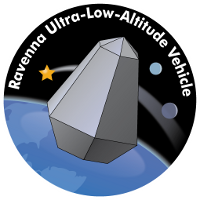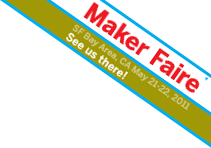Welcome to the RULAV!
The Ravenna Ultra-Low-Altitude Vehicle is a backyard rocketship treehouse nestled in the Seattle neighborhood of Ravenna. The best way to describe it is to show you a flight!Ours did.
The RULAV is a hexagonal capsule, 7.5 feet (2.3 meters) high, atop a tripod 7.5 feet (2.3 meters) high, for an overall height of about 15 feet (4.6 meters). It is about 6.5 feet (2 meters) across at its widest point. The frame is welded mild steel with riveted aluminum skin. It contains nearly 800 LEDs forming dozens of numeric displays spread across 14 control panels, each with an acrylic face laser-cut and etched with labels such as "Lunar Distance" and "Hydraulic Pressure". The pilot controls the rocket using a joystick and panels full of working switches, knobs and buttons. Underneath the capsule are three "thrusters" that shoot plumes of water and compressed air under the control of the pilot's joystick, simulating real positioning thrusters. Takeoff and docking sequences are augmented by a paint-shaker that simulates the vibration of a rocket engine. Sound effects complete the illusion, with a powered subwoofer that gives the rocket a satisfying rumble.
Behind the scenes, rocket operations are controlled by three Atmega328 microprocessors on custom-fabricated printed circuit boards, running a small operating system, RULOS, that we built just for this project. The processors communicate using an in-rocket TWI network and will eventually talk back to the house over a serial port. A trench running from the house to the rocket carries 12VDC power for the lighting and electronics, water for the thrusters, compressed air, and several data signals.
The RULAV was built in 2009-2010 by Jon Howell and Jeremy Elson, with lots of help from other people. This site describes the rocket's design and construction in detail, along with dozens of photos and videos.
And, if you're ever in the Seattle area, stop by and visit ... you are go for launch!

